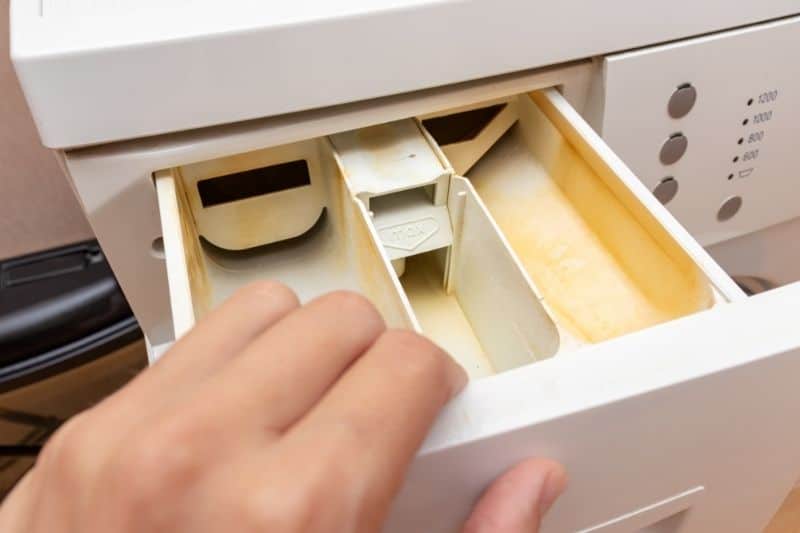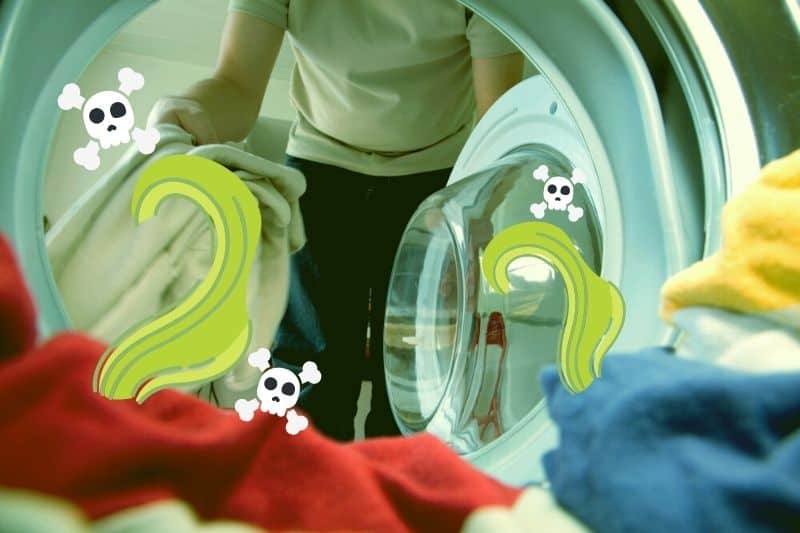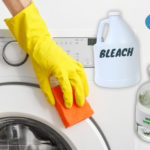Every now and again, washing machines can end up giving off an awful odour. If it is not dealt with, it can transfer onto laundry, leaving it smelling less than fresh.
These odours can be caused by a whole host of problems, and sometimes they do not go away immediately after cleaning the machine either.
What Causes the Smell?
The musty, damp, stagnant smell can be caused by all kinds of things. It can be caused by mould or a build-up of grime and bacteria.
The average washing load introduces hair, dirt, oils, and the odd bit of chunky debris into the washing machine (coins, hair clips etc.), and that is before you even consider the chemicals that you are cleaning with. If you live in a hard water area, the excess chalk can cause a problem too.
All these factors combined can lead to a build-up of grime, and a nasty odour.
This build-up of grime can be found just about anywhere – but the most common culprits are the door seal, detergent drawer, any lint filters, the drum, and the drainpipe.
Why Does It Smell Worse After Cleaning?
Unfortunately, it is possible that you could deep clean a washing machine and have it smell even worse afterwards. The reason for this is usually simple – you have loosened the dirt and the grime, but it has not been flushed away from the insides of the machine completely.
Aside from the smell being even worse, you might find that you can see black specks of dirt, or that the wastewater has a nasty colour to it.
This is especially likely to happen if you have cleaned the washing machine for the first time in a long while, or if you have been washing laundry that is dirty.
Fortunately, if this is the case, it can be quickly and easily rectified by running a second clean cycle. For some machines, a simple empty hot wash may suffice, but in more serious examples, an extra trick or two may be required to get the best results.
If you have run cleaning cycles multiple times and the smell just will not go away, check the drain to make sure that it is clear and there isn’t a backlog of stagnant water. If the drain is clear and you still have not shifted the smell, it may be worth contacting the manufacturer of the washing machine to see if they have any tips for your specific appliance.
Getting Rid of Washing Machine Odours
If you have cleaned the washing machine once already and it still smells, the best thing you could do is to do it again. Here are a few of our recommended tips for getting rid of a nasty smell in the washing machine:
Service wash
A service wash is simply a washing cycle designed to clean the inside of the washing machine. Therefore, these cycles are run empty. Some manufacturer guides may have directions on how to complete a service wash, so it is worth consulting their guides (or website if you lost the paperwork!) before getting started.
A simple service wash could just be running the machine empty at a hot temperature. Bacteria hate the heat, and so this can kill it off. If you need extra cleaning power, you can try adding soda crystals to the drum before starting the cycle.
Clean the seal
The seal around the washing machine door can get dirty, very quickly. The seal is exposed to dirty laundry, water, and chemicals all day long, so it is no surprise that this is a common culprit of a nasty smell.
If the seal has developed mould and it has been able to sit there unchallenged for long periods of time, it can start to damage the rubber seal itself. It is important to catch mould in the seal early on so that you do not need to fork out for a new door seal.
You can easily clean a mouldy washing machine door seal with white vinegar and a brush, such as a toothbrush or a nailbrush.
Check the drain
The drain is one of the biggest culprits of a nasty smell. If the drain has clogged up, it can lead to a backlog of stagnant water. Clogged drains can be easily cleared in several ways, including commercial unclogging agents, or with good old boiling water and baking soda.
Clean the detergent drawer

Detergent build-up creates the perfect home for mould and bacteria. If there is a serious build-up in your detergent drawer, clean it as soon as possible. Detergent drawers can be effectively cleaned using either generic cleaning chemicals or even white vinegar.
Preventing Nasty Smells
Preventing a problem is often easier than trying to cure it later on, and fortunately, there are steps that you can take to stop your washing machine from starting to smell. We recommend:
1. Consider changing your wash temperature
Today, many homes find themselves always using the washing machine at low temperatures, often around the 20 or 30 degrees mark. This is much more eco-friendly, but these temperatures are just not high enough to kill bacteria.
One way to combat this would be to increase your wash temperature. If you don’t want to increase the temperature of any wash, try to run some cycles at a higher temperature. As an example, I personally wash clothing at 30, but towels and bedding I try to wash at 60.
2. Run a service wash once a month
This point is especially important if every cycle you wash is at a low temperature. A service wash can be as simple as running a hot, empty cycle. Running this cycle once a month will cut through any bacteria and grime that has built up before it can start to smell rotten.
3. A dry drum is a fresh drum
Try to remove laundry as soon as the cycle has finished. This will stop water from going stagnant, keeping the drum fresh. If you are not immediately running another cycle, leave the machine door and the detergent drawer open. This allows fresh air to circulate and dry the surfaces.

Lover of coffee, painting, and all things cute and fluffy. I’m always on the lookout for easier, more gentle ways to tackle awful household chores.






